The Dynamic Prediction Method for Aircraft Cabin Temperatures Based on Flight Test Data
Abstract
:1. Introduction
2. Methods
2.1. Temperature Environment Partitions
2.2. Thermal Environment Analysis
- The aerodynamic thermal effect between the high-speed flow outside the aircraft and the skin;
- The radiation effect of the sun on the outer surface of the aircraft skin and the radiation heat exchange effect between the outer surface of the skin and the space environment, which comprehensively form the non-uniform radiation heat exchange field on the outer surface of the equipment skin;
- The exchange of airflow inside the aircraft’s non-airtight cabin and the airflow of the external atmospheric environment, including the cooling of the cabin by the ram air;
- The internal heat conduction process of the skin under the coupling of the internal and external thermal environments of the aircraft;
- The heat conduction–convection–radiation-coupled heat exchange process formed between the inner surface of the skin and the internal airflow and structural equipment of the equipment, which is a multimodal-coupled heat exchange process in a large and complex system;
- The heat exchange between the environmental control system and the equipment. After the environmental control intake and the airflow inside the equipment are mixed and exchanged, convection heat exchange occurs with the equipment inside the aircraft;
- The airflow and structural heat conduction between adjacent cabins;
- The heat generated by the equipment operation;
- The heat release from the engine combustion.
2.3. Dynamic Prediction Model Establishment
- It is assumed that air is an ideal gas and its physical properties satisfy the ideal gas state equation.
- It is assumed that the air temperature is evenly distributed in the same area.
- Assuming that the aircraft skin is very thin, it is assumed that the area inside and outside the skin is approximately equal.
- It is assumed that the gas pressure in the cabin remains constant and the airflow in and out of the cabin is equal.
2.4. Solving the Model Coefficients
3. Results and Discussion
3.1. Results
3.2. Discussion
4. Application of Temperature Prediction Model
4.1. Modification of Thermal Design Requirements and Solutions
4.2. Determination of Reliability Test Profile
5. Conclusions
- The temperature environment prediction model established by the research fully considers the heat transfer relationship between the inside and outside of the aircraft cabin and the dynamic changes of the heat transfer coefficient. It can separate the trend change term from the constant term, eliminate the change lag phenomenon in the previous temperature environment prediction, and realize the accurate dynamic prediction of the temperature environment inside the aircraft cabin.
- The measured data of the cabin temperature environment of 16 flights of an aircraft show that the prediction accuracy of the established prediction model is good after extrapolation. The model predicts that the maximum error does not exceed 2.8 °C at a confidence level of 95%, and the maximum root mean square error is 2.4 °C.
- The established temperature prediction model can reflect the actual temperature environment experienced by the onboard equipment in the aircraft cabin during its service life. Practical engineering applications show that the temperature environment prediction model can effectively support thermal design optimization and the formulation of test conditions.
- The established temperature prediction model is solved based on the data of flight tests. Therefore, the model is only applicable to current aircraft and helps to optimize and verify the design of airborne equipment after the test flight. In the future, it is recommended to conduct actual temperature environment measurements on more aircraft models to obtain a temperature prediction model that is common to different structural configurations and to guide the formulation and verification of the temperature environment’s worth for the design requirements of similar or new aircraft.
Author Contributions
Funding
Data Availability Statement
Acknowledgments
Conflicts of Interest
Nomenclature
| A | skin area, m2; |
| c | specific heat capacity of the cabin air, J/(kg·K); |
| cr | constant pressure specific heat capacity of ram air, J/(kg·K); |
| C1 | intermediate coefficient of the model, 1/(m·kg); |
| C2 | intermediate coefficient of the model, m; |
| C3 | intermediate coefficient of the model, m2·K/W; |
| C4 | intermediate coefficient of the model, m; |
| C5 | intermediate coefficient of the model, m2·K/W; |
| C6 | intermediate coefficient of the model, m3·K/(W·kg); |
| C7 | intermediate coefficient of the model, m4·K2/(W2·kg); |
| C8 | intermediate coefficient of the model, m; |
| C9 | intermediate coefficient of the model, m2·K/W; |
| C10 | intermediate coefficient of the model, J/kg; |
| d | Minkowski distance; |
| D2 | square distance between classes; |
| H | height, m; |
| h1 | convective heat transfer coefficient between the outer surface of the skin and the airflow, W/(m2·K); |
| h2 | convective heat transfer coefficient between the inner surface of the skin and the airflow, W/(m2·K); |
| k | specific heat ratio of the air; |
| k1 | intermediate coefficient of the model, kg·K/J; |
| k2 | intermediate coefficient of the model, m·K/W; |
| l | distance from the local position to the starting point of the boundary layer, m; |
| mi | mass of exchanged gas between adjacent cabins, kg; |
| mr−1 | mass of ram air entering the radar cabin per unit time, kg; |
| m1−r | mass of ram air flowing out of the radar cabin per unit time, kg; |
| Ma | flight Mach number; |
| n | the number of elements in the sample; |
| n0 | exponent; |
| n1 | total number of cabins adjacent to Zone 1; |
| Nu | Nusselt number, W/(m·K); |
| p | atmospheric pressure, Pa; |
| Pr | Prandtl number; |
| Qc | heat exchange between the zone and the adjacent cabin, J; |
| QE | heat generated by the electronic equipment, J; |
| QE0 | basic heat dissipation of the electronic equipment, J; |
| Qm | heat exchanged between the cabin air and the outside air, J; |
| QTr | amount of heat applied to the cabin air by aerodynamic heating through the skin, J; |
| q | factor of Minkowski; |
| R | molar gas constant, 8.314 J/(mol·K); |
| R0 | gas constant, 287.06 J/(kg·K); |
| Ri | total thermal resistance between adjacent cabins, m2·K/W; |
| Re | Reynolds number; |
| r | correlation coefficient; |
| r1 | intermediate coefficient of the model, m2·K/W; |
| T | air temperature in the zone, °C; |
| TH | atmospheric temperature at the flight altitude, °C; |
| Ti | temperature of the i-th adjacent cabin, °C; |
| Tp | temperature of the prediction value, °C; |
| Tr | skin surface recovery temperature, °C; |
| Tt | temperature of the test value, °C; |
| t | time, s; |
| U | temperature sample of a single measuring point; |
| v0 | airflow velocity, m/s; |
| x | elements in the sample; |
| Y | terms in Equation (21); |
| α | average of data; |
| δ | skin thickness, m; |
| γ | recovery factor; |
| λ | thermal conductivity of the skin material, W/(m·K); |
| μ | air viscosity coefficient, Pa·s; |
| ρ0 | air density, kg/m3; |
| σ | data standard deviation. |
References
- Equipment Development Department of the Central Military Commission of Communist Party of China. Materiel Environment Engineering Terms; Publication and Distribution Department of Military Standards, GAD: Beijing, China, 2007. [Google Scholar]
- Fu, Y.; Chang, H.J.; Wu, Y.Q.; Xue, H. Dynamic temperature predicted model for airplane platform based on measured data. Acta Aeronaut. Astronaut. Sin. 2014, 35, 2472–2480. [Google Scholar]
- Sanchez, F.; Liscouet-Hanke, S. Thermal Risk Prediction Methodology for Conceptual Design of Aircraft Equipment Bays. Aerosp. Sci. Technol. 2020, 104, 105946. [Google Scholar] [CrossRef]
- Sanchez, F.; Huzaifa, A.M.; Liscouet-Hanke, S. Ventilation Considerations for an Enhanced Thermal Risk Prediction in Aircraft Conceptual Design. Aerosp. Sci. Technol. 2021, 108, 106401. [Google Scholar] [CrossRef]
- Li, H.; Zhang, J.J.; Fu, Y.; Shi, H.; Wan, J. Research on the Analysis and Prediction Method of Aircraft Temperature Environment in Severe Cold Areas. Environ. Technol. 2022, 40, 174–182. [Google Scholar]
- Zhang, T.; He, Y.T.; Li, C.F.; Zhang, H.W.; Hou, B. Research on Local Temperature Environment of Ground Parking Aircraft. Acta Aeronaut. Astronaut. Sin. 2015, 36, 538–547. [Google Scholar]
- Wang, T.; Wang, J. Ambient Temperature Flight Test of Airplane Nacelle and Analysis of Flight Result of One Aircraft. Mod. Mater. 2014, 1, 39–40. [Google Scholar]
- Bao, S.; Wang, J.T.; Si, J.S.; Qi, C.W.; Chu, X.; Wang, C. Ambient Temperature Inside Liquid-cooled Electronic Pod. Equip. Environ. Eng. 2022, 19, 80–85. [Google Scholar]
- Zhang, Y.H.; Shi, M.L. Analysis on Operating Temperature for Air-to-Air Missiles. Equip. Environ. Eng. 2015, 12, 99–103. [Google Scholar]
- Li, D.P.; Zhu, P.P.; Chen, S.Q.; Pan, H.; Li, R.Q. Application of Linear Regression Analysis on Liquid Rocket Propellant Temperature Prediction. Missile Space Veh. 2020, 1, 43–47. [Google Scholar]
- Zhao, S.Y.; Tian, R.L.; Wang, C.G.; Wang, W.J. Research on Environmental Conditions of Temperature and Humidity inside Container in Southeast Coast Region. Equip. Environ. Eng. 2007, 4, 44–47. [Google Scholar]
- Li, H.B. BP Neural Network Prediction Method based on Temperature. Electron. Test 2013, 19, 62–64. [Google Scholar]
- Li, H.; Zhang, J.J.; Fu, Y.; Xu, J.; Hao, Y.J. Research on Dynamic Prediction Method of Temperature Environment of Unmanned Aerial Vehicle Platform based on Physical Information and Neural Network. J. Phys. Conf. Ser. 2024, 2746, 012027. [Google Scholar] [CrossRef]
- Lu, Y.; Zhang, J.J.; Fu, Y.; Liu, C. Seeker Cabin Temperature Prediction Based on Elman Neural Network in Airport Parking Conditions. Equip. Environ. Eng. 2020, 17, 21–26. [Google Scholar]
- Fermin, U.J.; Benjamin, R.; Alain, D. Model Identification for Temperature Extrapolation in Aircraft Powerplant Systems. Int. J. Therm. Sci. 2013, 64, 162–177. [Google Scholar]
- Ying, Z.; Wang, T.; Xiao, J.; Feng, X. Temperature Prediction of Electrical Equipment Based on Autoregressive Integrated Moving Average Model. In Proceedings of the 2017 32nd Youth Academic Annual Conference of Chinese Association of Automation (YAC), Hefei, China, 19–21 May 2017; pp. 197–200. [Google Scholar]
- Yang, C.; Pang, L.P.; Wang, J.; Yue, Z.; Qu, H. Study on the Method of Thermal Prediction for Electronic Wing Pod Cabin. In Proceedings of the IECON 2017—43rd Annual Conference of the IEEE Industrial Electronics Society, Beijing, China, 29 October–1 November 2017. [Google Scholar]
- Liu, R.; Song, J.; Luo, P.; Tian, F.; Li, W. Analysis and Prediction of Temperature of an Assembly Frame for Aircraft based on BP Neural Network. Int. J. Comput. Mater. Sci. Eng. 2023, 12, 2350006. [Google Scholar] [CrossRef]
- Sheng, Z.Y.; Fu, S.; Wang, Y.P.; Qu, H.Q. Application of RVFL Neural Network in Temperature Prediction of Equipment cabin. China Sci. 2018, 13, 877–892. [Google Scholar]
- Chen, G.Y.; Yang, S.; Peng, W.; Duo, L.L.; Zhang, J.P.; Liu, X.C. Transient Temperature Prediction Method for Spacecraft Using Process Neural Network. Spacecr. Eng. 2023, 32, 25–30. [Google Scholar]
- Xia, Q.; Qiu, S.; Liu, X.Y.; Liu, M.; Guo, J.S.; Lin, X.H. Data-driven based Approach for Intelligent Temperature Forecasting of in-orbit Satellites. Syst. Eng. Ang Electron. 2024, 46, 1619–1627. [Google Scholar]
- Mahulikar, S.P.; Kolhe, P.S.; Rao, G.A. Skin-Temperature Prediction of Aircraft Rear Fuselage with Multimode Thermal Model. J. Thermophys. Heat Transf. 2005, 19, 114–124. [Google Scholar] [CrossRef]
- Zhang, Q. Calculation of Transient Heat Load for Aircraft Cabins. Master’s Thesis, Nanjing University of Aeronautics and Astronautics, Nanjing, China, 2009. [Google Scholar]
- Luo, C.; Wan, J.; Ding, C.; Sun, Y.S. Predicting Method of Missile Storage Temperature Based on Thermal Network Model. Equip. Environ. Eng. 2017, 14, 89–92. [Google Scholar]
- Pang, L.P.; Zhao, M.; Luo, K.; Yin, Y.; Yue, Z. Dynamic Temperature Prediction of Electronic Equipment under High Altitude Long Endurance Conditions. Chin. J. Aeronaut. 2018, 31, 1189–1197. [Google Scholar] [CrossRef]
- Li, H.; Zhang, J.; Fu, Y.; Hao, Y.; Xu, J.; Zhong, Y. Research on Data-Driven Integrated Environment Prediction Method for the Typical Cabin of Helicopter. In Proceedings of the 2023 Global Reliability and Prognostics and Health Management Conference (PHM-Hangzhou), Hangzhou, China, 12–15 October 2023; pp. 1–6. [Google Scholar]
- Lv, Y.G.; Ren, G.J.; Liu, Z.X.; Kang, Z. Thermal Analysis of Fuel Tank for Aircraft. J. Propuls. Technol. 2015, 36, 61–67. [Google Scholar]
- Chen, Y.L.; Zhu, J.Z.; Chen, T.M.; Zhu, C.C.; Wei, P.T.; Xu, Y.Q. Study on Operating Temperature Prediction Model of Aero High-speed Gears. J. Mech. Transm. 2024, 48, 1–9. [Google Scholar]
- Yin, J.B.; Wang, S.S.; Hou, X.; Hou, X.; Wang, Z.X.; Xu, Z. Transient Prediction Model of Finned Tube Storage Energy System based on Thermal network. Appl. Energy 2023, 38, 2395–2406. [Google Scholar] [CrossRef]
- Liang, P.; He, T.; Liang, L.; Jiao, N.; Liu, W. Analytical Thermal Model of Slot for Electric Propulsion Motor in Electric Aircraft. IEEE Trans. Energy Convers. 2023, 38, 2662–2670. [Google Scholar] [CrossRef]
- Yang, D. A Research on Design and Application of Kalman Filter. Master’s Thesis, Xiangtan University, Xiangtan, China, 2015. [Google Scholar]
- Chen, T.T. Comparative Study of Cluster Analysis Method. Math. Comput. 2018, 7, 24–29. [Google Scholar]
- Equipment Development Department of the Central Military Commission of Communist Party of China. Reliability Testing for Qualification and Production Acceptance; Publication and Distribution Department of Military Standards, GAD: Beijing, China, 2009. [Google Scholar]
- Xia, L.L. Research on the Calculation of Transient Heat Load of Aircraft Cabins. Master’s Thesis, Nanjing University of Aeronautics and Astronautics, Nanjing, China, 2010. [Google Scholar]
- Yang, S.M.; Tao, W.Q.B. Heat Transfer, 4th ed.; Higher Education Press: Beijing, China, 2006; p. 212. [Google Scholar]
- Wang, X.Y. Fundamentals of Gas Dynamics, 1st ed.; Northwestern Polytechnical University Press: Xi’an, China, 2006; p. 111. [Google Scholar]
- International Organization for Standard. Standard Atmosphere; ISO: Geneva, Switzerland, 1975. [Google Scholar]
- Commission of Science, Technology and Industry for National Defense. Climatic Extremes for Military Equipment; Publication and Distribution Department of Military Standards, COSTIND: Beijing, China, 1991. [Google Scholar]

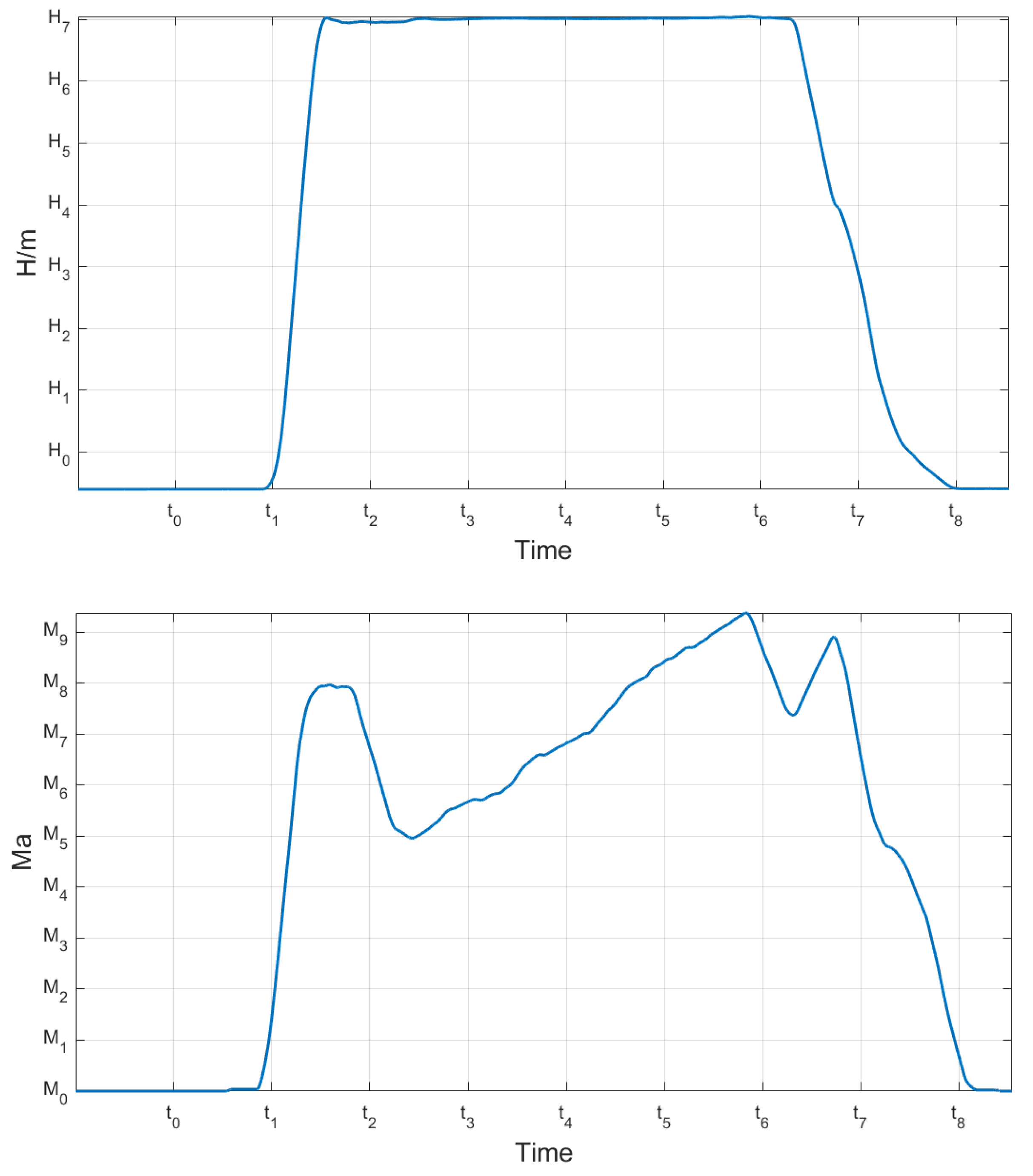
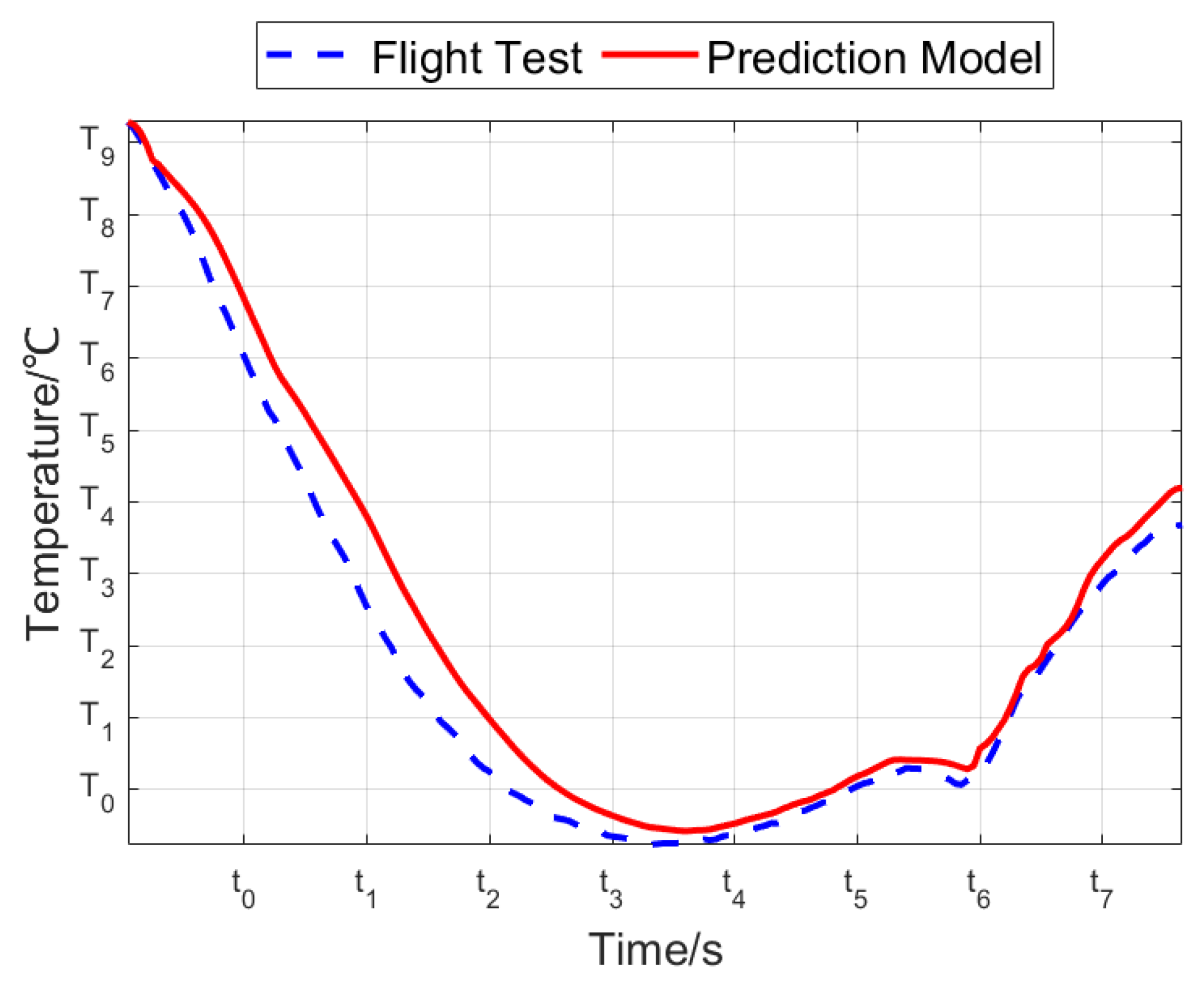

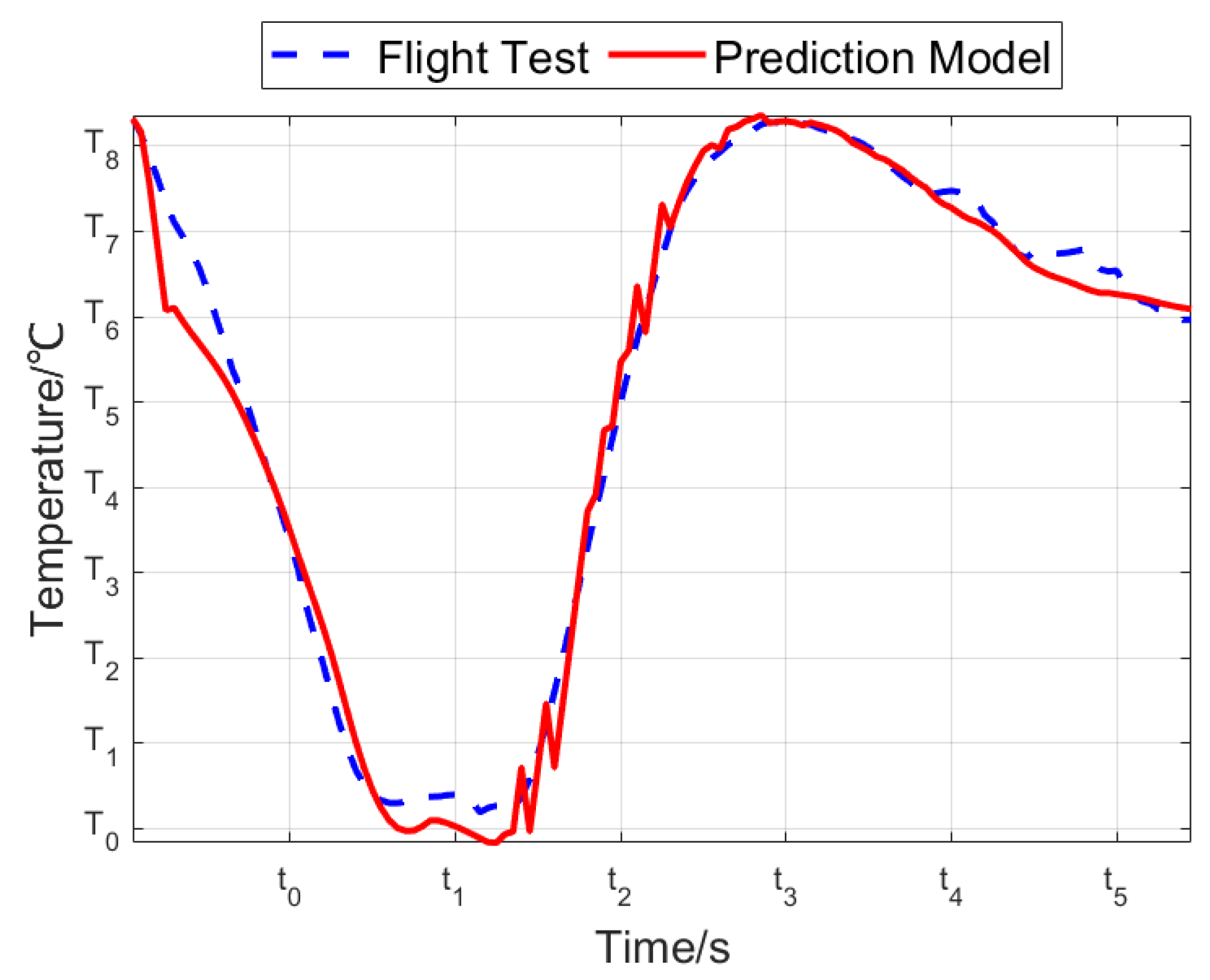
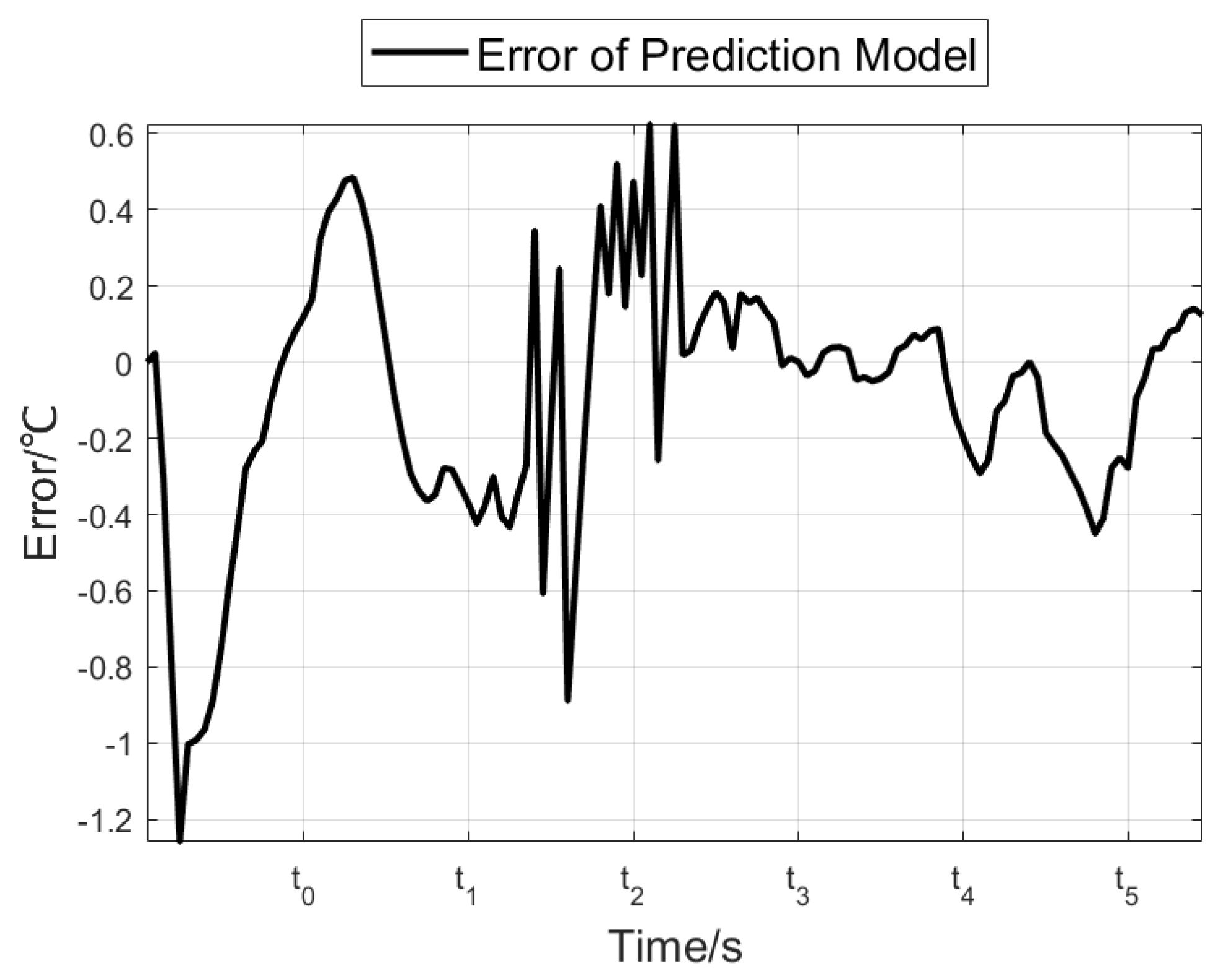
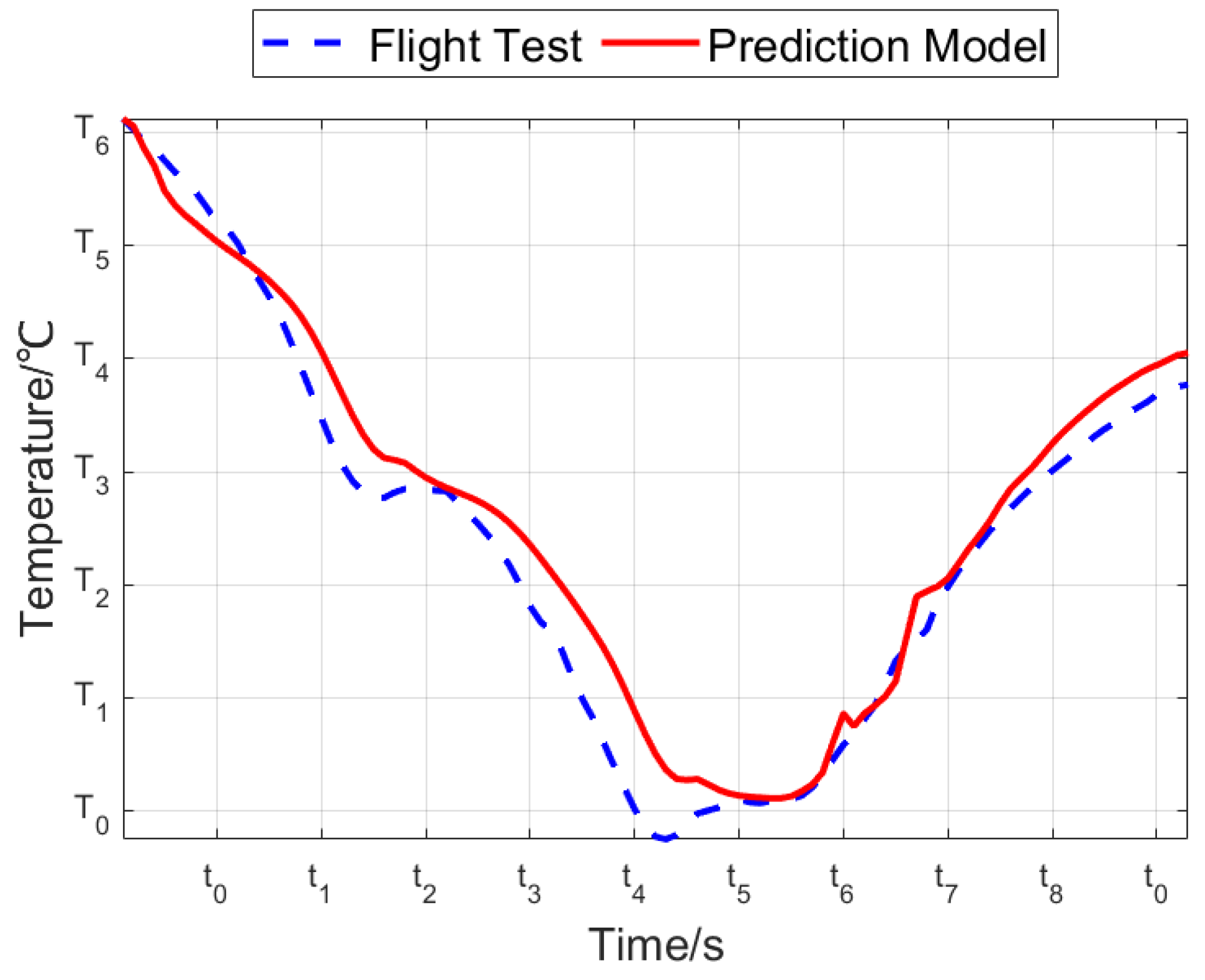


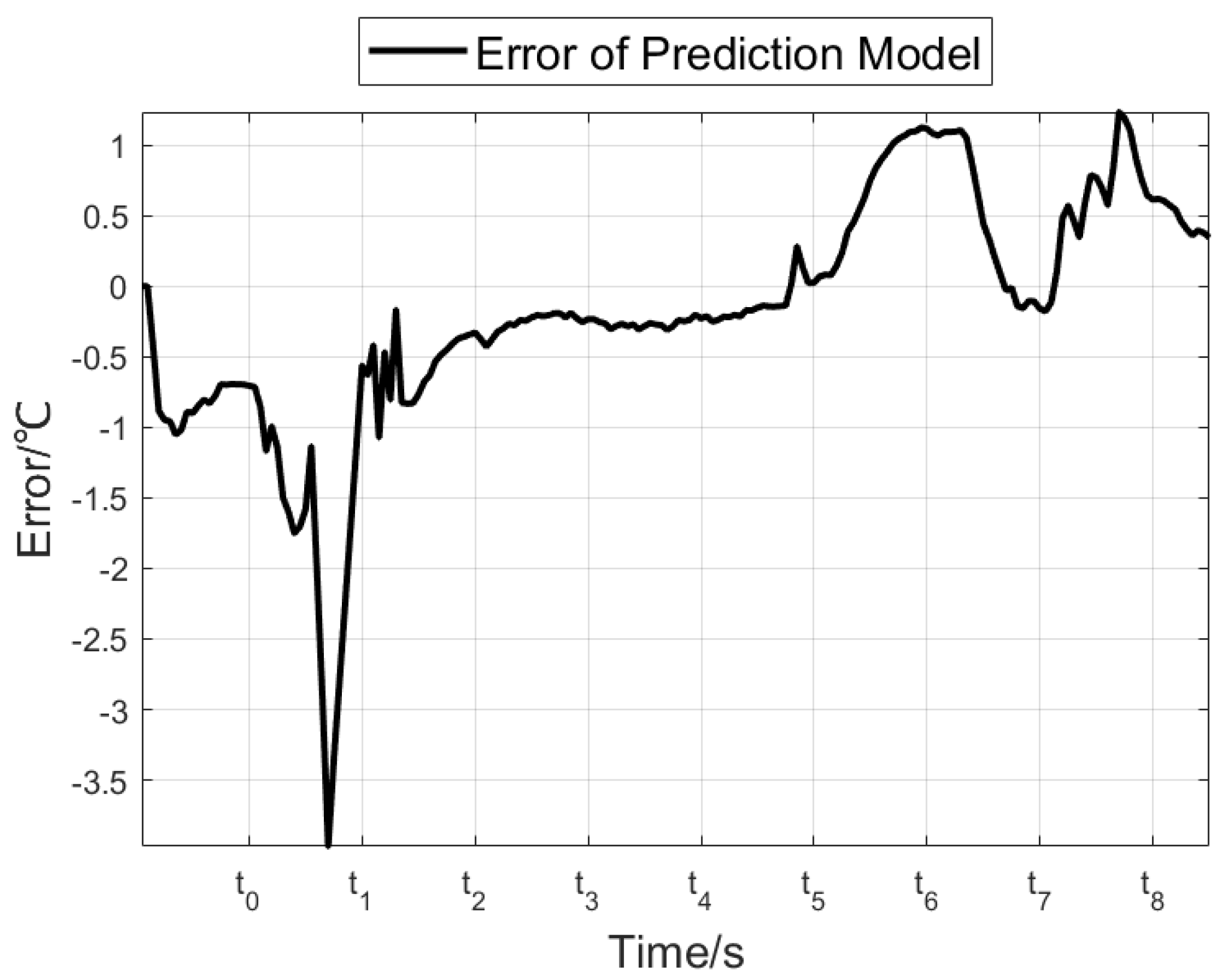
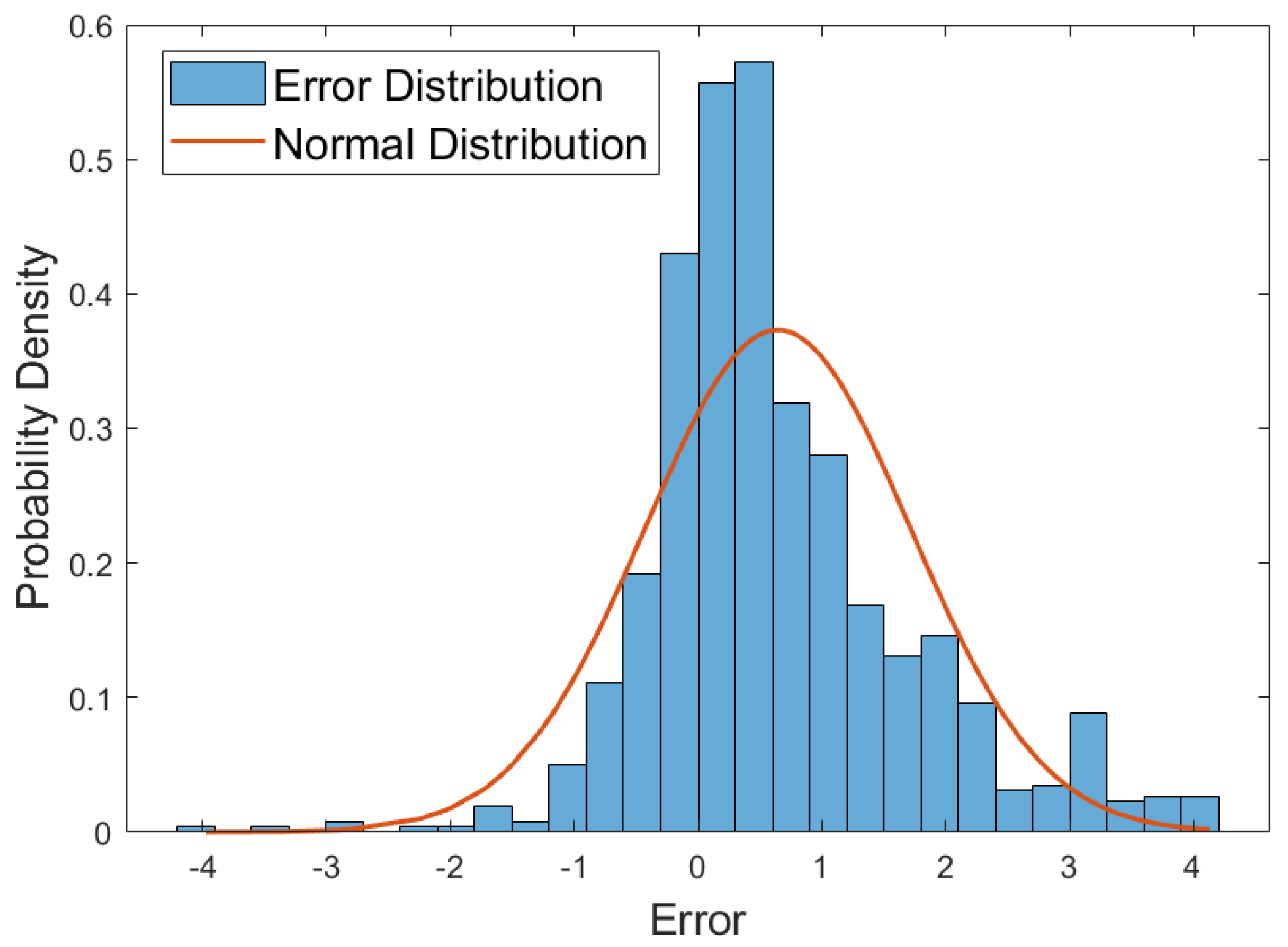


| Structural Partitions | Data Set | Cluster Partitioning | Data Set |
|---|---|---|---|
| Forepart | U1, U2, …, U6 | Zone 1 | U1 |
| Zone 2 | U2, U3 | ||
| Zone 3 | U4, U5, U6 | ||
| Central | U7, U8, …, U24 | Zone 4 | U7, U8 |
| Zone 5 | U9, U10, …, U18 | ||
| Zone 6 | U19, U20, …, U24 | ||
| Rear | U25, U26, …, U30 | Zone 7 | U25, U26, U28 |
| Zone 8 | U29, U31 | ||
| Zone 9 | U27, U30 |
| Coefficient | C1 | C2 | C3 | C4 | C5 | C9 | C10 | C11 | n0 |
|---|---|---|---|---|---|---|---|---|---|
| Value | 0.477 | 0.0037 | −4.95 × 10−4 | 0.0032 | −4.93 × 10−4 | −7.48 × 10−7 | −2.08 × 10−4 | −0.0055 | 0.5 |
| Flight Profile | MAE (°C) | RMSE (°C) | Extreme Value Prediction Error (°C) |
|---|---|---|---|
| A | 2.5 | 1.1 | 0.4 |
| B | 0.6 | 0.4 | 0.4 |
| C | 1.8 | 0.7 | 0.7 |
| D | 1.2 | 0.8 | 0.9 |
| E | 2.4 | 0.9 | 0.4 |
| F | 2.4 | 1.3 | 0.7 |
| G | 2.5 | 1.2 | 1.5 |
| H | 4.0 | 1.3 | 1.1 |
| I | 1.7 | 0.8 | 0.6 |
| J | 4.1 | 2.4 | 0.2 |
| K | 2.3 | 1.3 | 1.6 |
| L | 1.5 | 0.8 | 0.8 |
| M | 3.2 | 1.6 | 3.1 |
| N | 3.5 | 2.1 | 3.0 |
| O | 2.8 | 1.2 | 0.4 |
| P | 3.1 | 1.1 | 0.1 |
| Height (km) | Temperature (°C) | |||
|---|---|---|---|---|
| Ma | ||||
| ≤0.4 | 0.6 | 0.8 | ≥1 | |
| 0 | −44 | −37 | −25 | −11 |
| 3 | −18 | −10 | 2 | 19 |
| 6 | −36 | −28 | −16 | −2 |
| 9 | −58 | −50 | −40 | −27 |
| 12 | −59 | −51 | −41 | −28 |
| 15 | −85 | −76 | −67 | −55 |
| 18 | −82 | −75 | −66 | −54 |
| 21 | −65 | −58 | −48 | −35 |
| Height (km) | Temperature (°C) | |||
|---|---|---|---|---|
| Ma | ||||
| ≤0.4 | 0.6 | 0.8 | ≥1 | |
| 0 | 48 | 60 | 75 | 95 |
| 3 | 27 | 38 | 52 | 71 |
| 6 | 6 | 16 | 29 | 46 |
| 9 | −15 | −6 | 7 | 23 |
| 12 | −36 | −30 | −16 | −1 |
| 15 | −30 | −19 | −7 | 8 |
| 18 | −31 | −23 | −11 | 4 |
| 21 | −30 | −22 | −10 | 5 |
Disclaimer/Publisher’s Note: The statements, opinions and data contained in all publications are solely those of the individual author(s) and contributor(s) and not of MDPI and/or the editor(s). MDPI and/or the editor(s) disclaim responsibility for any injury to people or property resulting from any ideas, methods, instructions or products referred to in the content. |
© 2024 by the authors. Licensee MDPI, Basel, Switzerland. This article is an open access article distributed under the terms and conditions of the Creative Commons Attribution (CC BY) license (https://creativecommons.org/licenses/by/4.0/).
Share and Cite
Li, H.; Zhang, J.; Cai, L.; Li, M.; Fu, Y.; Hao, Y. The Dynamic Prediction Method for Aircraft Cabin Temperatures Based on Flight Test Data. Aerospace 2024, 11, 755. https://doi.org/10.3390/aerospace11090755
Li H, Zhang J, Cai L, Li M, Fu Y, Hao Y. The Dynamic Prediction Method for Aircraft Cabin Temperatures Based on Flight Test Data. Aerospace. 2024; 11(9):755. https://doi.org/10.3390/aerospace11090755
Chicago/Turabian StyleLi, He, Jianjun Zhang, Liangxu Cai, Minwei Li, Yun Fu, and Yujun Hao. 2024. "The Dynamic Prediction Method for Aircraft Cabin Temperatures Based on Flight Test Data" Aerospace 11, no. 9: 755. https://doi.org/10.3390/aerospace11090755







